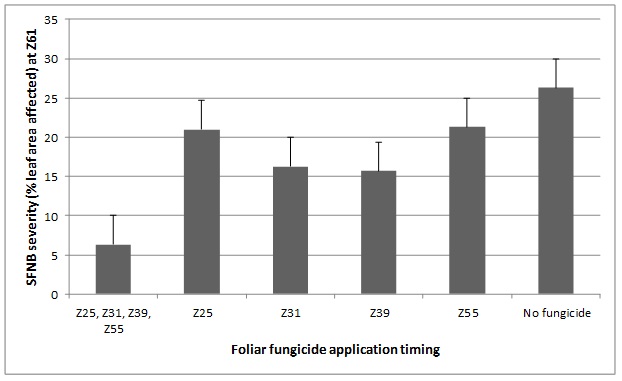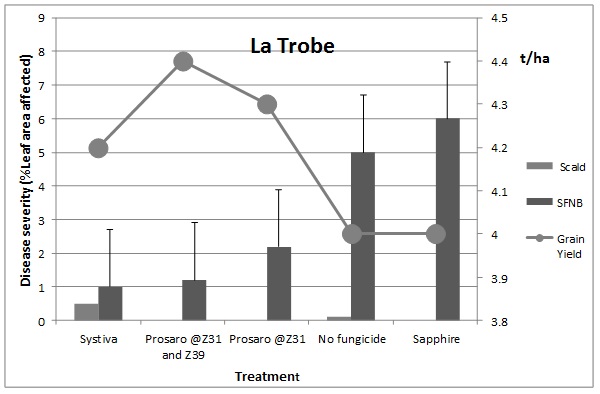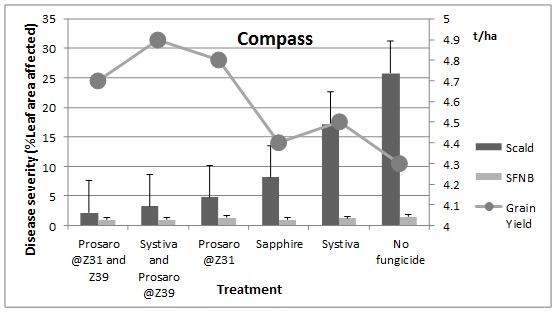Spot form of net blotch yield loss and management in barley using fungicides and resistance in Victoria
Author: Mark McLean and Grant Hollaway | Date: 24 Feb 2015
Mark McLeanand Grant Hollaway, Department of Economic Development, Jobs, Tourism and Resources.
ɸExtra technical comment by Protech Consulting Pty Ltd
GRDC project code: DAV00129
Keywords: spot form of net blotch, yield loss, fungicide, resistance
Take home messages
- Spot form of net blotch (SFNB) caused up to 25% loss in grain yield and quality in very susceptible barley varieties during 2014.
- Varieties rated moderately susceptible or better to SFNB had significantly less grain yield and quality loss than susceptible varieties.
- Foliar fungicides provided effective suppression of SFNB when applied at Z31 and/or Z39.
- A new seed applied fungicide provided very good suppression of SFNB during the early stages of crop development.
Background
Spot form of net blotch (SFNB) is a common foliar disease of barley in south-eastern Australia due to the widespread cultivation of susceptible varieties, stubble retention and favourable climatic conditions (McLean et al. 2009). SFNB has been reported to cause up to 44% grain yield loss and significant reductions in grain plumpness where severe. Losses due to SFNB generally occur when infection severity is greater than 10% on the top four leaves at grain fill stage (Jayasena et al. 2002; 2007), and is most likely during wet seasons.
Resistant barley varieties and foliar fungicides are currently the most effective management options for SFNB. A new seed treatment is undergoing registration for suppression of SFNB and will provide an additional option in the future. Stubble management is less effective as infected stubble can take up to 3 years to break down, even when cultivated.
SFNB yield loss and management experiments have been conducted by the Department of Economic Development, Jobs, Tourism and Resources (DEDJTR) since 2005 to help determine the economic benefits of managing SFNB and to identify the best management strategies. During 2014, the first of a series of collaborative experiments with BCG was conducted in the Mallee region. These studies aim to help growers prioritise management strategies and make informed decisions about the most suitable barley varieties to grow and when to apply fungicides. The experiments are part of the GRDC project DAV00129.
Methodology
Eleven SFNB yield loss and foliar fungicide, one resistance and one variety x fungicide experiments were conducted by DEDJTR during 2005-14 to identify effective management strategies for SFNB in barley.
Yield loss
Grain yield and quality loss due to SFNB was determined in eleven experiments conducted during 2005-12. In each experiment, a very susceptible variety was sown and six replicate plots of two treatments applied including: 1) Fungicide treatment consisting of at least four applications (Z25, Z31, Z39 and Z55) of foliar fungicide (propiconazole [250 g/litre] at 250 ml/ha) throughout the growing season to minimise disease; and 2) disease treatment consisting of application of infected stubble and no foliar fungicide. Grain yield and quality loss was determined by comparing the two treatment's grain yield and quality measurements of screenings, retention and 1,000 grain weight.
Resistance
Eight barley varieties representing different resistance/susceptibility ratings were evaluated at Quambatook as part of an ongoing five year project which will see similar experiments conducted during the 2015 and 2016 growing seasons. Fungicide and disease treatment were applied as described above to compare grain yield and quality. SFNB severity, grain yield and quality were determined as described above.
Fungicides
Spot form of net blotch suppression following foliar fungicide (propiconazole [250 g/litre] at 250 ml/ha) application was evaluated in seven experiments conducted during 2005-11. The growth stages, tillering (Z25), stem elongation (Z31), flag emergence (Z39) and ear emergence (Z55) were targeted with six replicate plots of each treatment. SFNB severity was estimated visually on the top four leaves of ten tillers within each plot. Grain yield and quality measurements of screenings, retention and 1000 grain weight were determined as above.
Variety x fungicide
SFNB and scald suppression provided by seed, fertiliser and foliar applied fungicides was evaluated for two varieties, Compass and La Trobe in one experiment at Horsham during 2014. A new seed applied fungicide Systivaa (fluxapyroxad) (150 ml/100kg of seed), foliar applied fungicide Prosaro® (prothioconazole/tebuconazole) (300ml/ha) and fertiliser applied fungicide, Saphireb (flutriafol) (560ml/100kg) were compared. Foliar fungicide was applied at stem elongation and/or flag emergence. Barley stubble naturally infected with SFNB and scald was applied to all barley plots. Six replicates of each treatment were tested and each plot assessed for disease severity, grain yield and quality as described above (ɸaNot yet registered, ɸbNot registered for spot form, only for suppression of net form).
Results and discussion
Grain yield and quality loss
SFNB caused 4-25% (0.1-0.9 t/ha) grain yield loss in the Wimmera region of Victoria during 2005-12 (Table 1). Significant yield loss was recorded in six out of eleven experiments, typically during seasons of average or above average rainfall during the spring months. Grain yield losses were insignificant during dry seasons. These grain yield losses would have resulted in an estimated income loss of $15-220 per hectare, based on barley price range of $150-240/t.
Spot form of net blotch caused significant reductions in grain quality measurements in seven out of the eleven experiments with up to 5% increase in screenings, and 13% and 6% reduction in retention and grain weight respectively. The grain quality losses were recorded during seasons of average or above rainfall during the winter and spring months and occasionally during dry seasons. These grain quality reductions could potentially affect the grading at receival, reducing income by $60-240/ha, based on barley price range of $150-240/t.
Table 1. Grain yield and quality loss of a very susceptible rated barley variety in the Wimmera region of Victoria during 2005-11.
|
Year |
Location |
Variety |
Grain yieldA (t/ha) |
ScreeningsA (%<2.2 mm) |
RetentionA (%>2.5 mm) |
1,000 grain-weightA (g) |
|---|---|---|---|---|---|---|
|
2005 |
Horsham |
Gairdner |
-25* |
0ns |
-5ns |
-2ns |
|
2007 |
Horsham |
Dash |
-6* |
0ns |
-6* |
-2ns |
|
2007 |
Wonwondah |
Dash |
-4* |
+5* |
-10ns |
-6* |
|
2008 |
Wonwondah |
Dash |
-6ns |
0ns |
-1ns |
0ns |
|
2009 |
Horsham |
Dash |
-5ns |
0ns |
-7* |
-2ns |
|
2009 |
Wonwondah |
Dash |
-4ns |
+1* |
-6* |
-2ns |
|
2010 |
Wonwondah |
Dash |
-14* |
+2ns |
-6* |
-4ns |
|
2010 |
Longerenong |
Dash |
-8* |
0ns |
-2ns |
0ns |
|
2010 |
Horsham |
Dash |
-7ns |
+1ns |
-11* |
0ns |
|
2011 |
Horsham |
Dash |
-8* |
+3* |
-13* |
-5* |
|
2012 |
Horsham |
Dash |
-7ns |
0ns |
-2ns |
-2ns |
AComparison between fungicide and disease treatments. Fungicide treatment consisted of the application of foliar fungicide (propiconazole [250 g/litre] at 250 ml/ha) on multiple occasions throughout the growing season and no infected barley stubble applied. Disease treatment consisted of application of barley stubble, naturally infected with Pyrenophora teres f. maculata and no foliar fungicide applied. * = significantly different (P=0.05) between the fungicide and disease treatments, ns = not significant
Resistance
Avoiding growing very susceptible barley varieties reduces the risk of loss due to SFNB. This was demonstrated in an experiment conducted at Quambatook during 2014 (Table 2) where SFNB reduced grain yield by 6 to 11% (0.2-0.3t/ha) in the very susceptible varieties Hindmarsh and SY Rattler, while susceptible or better rated varieties received no significant yield loss (0-3%).
Grain quality measurements were also typically affected according to resistance/susceptibility rating with increased screenings of 4 to 7% and reduced retention of 3 to 13% in susceptible and very susceptible varieties. Grain quality was least affected in the moderately susceptible varieties. Significant loss of retention was also recorded for Fathom, but this was unlikely to be a result of SFNB. Grain protein and test weight were unaffected by SFNB (data not shown).
These results demonstrate that SFNB should also be managed in the Mallee region where there is reasonable crop yield potential and favourable climatic conditions.
Table 2. Grain yield and quality response of eight barley varieties with different resistance/susceptibility ratings foliar fungicide (Prosaro®) application in the presence of SFNB at Quambatook during 2014.
|
Variety |
SFNB severity Disease Treatment Z85 (%LAA) |
Yield LossA |
Screenings IncreaseA |
Retention LossA |
|---|---|---|---|---|
|
Fathom (MR) |
2.3 |
-0.1 (3%) |
+1% |
-7%* |
|
Compass (MS) |
5.5 |
0 |
0 |
-3% |
|
Flagship (MS) |
3.7 |
-0.1 (3%) |
+3% |
-5% |
|
Vlamingh (S) |
7.2 |
-0.1(3%) |
+1%* |
-8%* |
|
La Trobe (S) |
9.2 |
-0.1 (3%) |
+3%* |
-10%* |
|
Hindmarsh (VS) |
11.2 |
-0.2 (6%)§ |
+4%* |
-13%* |
|
Dash (VS) |
12.5 |
-0.2 (7%) |
+4% |
-3% |
|
SY Rattler (VS) |
21.7 |
-0.3 (11%)* |
+7%* |
-6%§ |
AComparison between fungicide and disease treatments. Fungicide treatment consisted of the application of foliar fungicide (propiconazole [250 g/litre] at 250 ml/ha) on multiple occasions throughout the growing season and no infected barley stubble applied. Disease treatment consisted of application of barley stubble, naturally infected with Pyrenophora teres f. maculata and no foliar fungicide applied. *= significantly different at 5%, §significantly different at 10%
Foliar fungicides
Foliar fungicides can be used to manage SFNB in susceptible varieties, however the benefits vary depending on the seasonal conditions and yield potential of the crop. Application at stem elongation (Z31) or flag emergence (Z39) generally provides the best suppression of SFNB (Figure 1), however the best timing varies between seasons. The best strategy is to apply foliar fungicide at both Z31 and Z39 to maximise suppression when the crop is producing the most biomass. In most cases one application of foliar fungicide is unlikely to eliminate losses, especially when SFNB is severe.

Figure 1. Effect of foliar fungicide application (propiconazole @ 250 ml/ha) at different crop developmental stages on SFNB severity on the top four leaves of a susceptible barley variety at Wonwondah, Victoria during 2007. P=<0.001 LSD (0.05)=3.878
Variety x fungicide
Spot form of net blotch and scald severity varied between the two varieties according to respective ratings. La Trobe was primarily affected by SFNB, while Compass was primarily affected by scald. The effectiveness of each fungicide strategy varied. A single application of foliar fungicide (Prosaro® @ 300 ml/ha) at stem elongation (Z31) and a combined application at stem elongation (Z31) and flag emergence (Z39) provided effective disease suppression for both varieties (Figures 2 and Figure 3) and provided significant improvement in grain yield compared to the no fungicide control.
The fertiliser applied fungicide, Sapphire provided some suppression of scald, but did not significantly improve grain yield, indicating that a follow-up application of foliar fungicide was required. The new seed treatment, Systivaa provided good suppression of SFNB and some yield benefits for La Trobe; and provided reasonable suppression of scald and yield improvements in Compass, however, the greatest yield benefits were observed in Compass when Systiva® was combined with foliar fungicide at flag emergence (Z39). This was due to disease suppression throughout majority of the crop’s development, coinciding with the wet climatic conditions.
(ɸaNot yet registered)

Figure 2. Effect of seed (Systiva®), fertiliser (Sapphire) and foliar fungicide (Prosaro® @ 300 ml/ha) application at different crop developmental stages on SFNB and scald severity at Z89 in barley variety La Trobe at Horsham during 2014.

Figure 3. Effect of seed (Systiva®), fertiliser (Sapphire) and foliar fungicide (Prosaro® @ 300 ml/ha) application at different crop developmental stages on SFNB and scald severity at Z89 in barley variety Compass at Horsham, during 2014.
Conclusion
SFNB caused significant grain yield and quality loss in susceptible barley varieties grown in the Wimmera and Mallee regions of Victoria. Losses were greater during seasons with average or greater rainfall during the winter and spring months and low to negligible during dry seasons. Yield loss was typically 5 to 10% and grain plumpness significantly affected as demonstrated by reduced retention of 6 to 13%. Growing moderately susceptible or better varieties significantly reduced the risk of loss.
Application of foliar fungicide at stem elongation (Z31) and/or flag emergence (Z39) provided good suppression of SFNB and other major diseases such as scald, however the benefits were variable in response to seasonal conditions and didn’t necessarily eliminate loss. A combination of foliar fungicide at both Z31 and Z39 provided the best suppression in most cases. A new seed treatment called Systivaa provided good suppression of SFNB and scald, however disease suppression was better when combined with a foliar fungicide application of a different product at Z39. Both of these strategies were shown to provide significant increases in grain yield where there was good yield potential. (ɸaNot yet registered).
Acknowledgements
We would like to thank GRDC and Department of Economic Development, Jobs, Tourism and Resources for funding and support; technical staff in the cereal pathology group for technical support; and the BCG for conducting the experiment at Quambatook.
References
Jayasena KW, Loughman R, Majewski J (2002) Evaluation of fungicides in control of spot-type net blotch on barley. Crop Protection 21, 63–69.
Jayasena KW, van Burgel A, Tanaka K, Mejewski J, Loughman R (2007) Yield reduction in barley in relation to spot-type net blotch. Australasian Plant Pathology 36, 429–433.
McLean MS, Howlett BJ and Hollaway GJ (2009) The epidemiology and control of spot form of net blotch (Pyrenophora teres f. maculata) of barley: a review. Crop & Pasture Science 60, 303–315.
Contact details
Mark McLean
110 Natimuk Road, Horsham, Vic, 3401
03 5362 2313
Mark.mclean@depi.vic.gov.au
@msmclean777
GRDC Project Code: DAV00129,
Was this page helpful?
YOUR FEEDBACK
